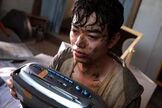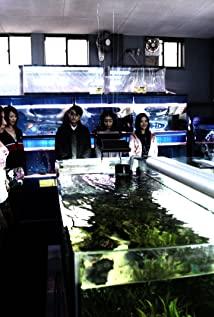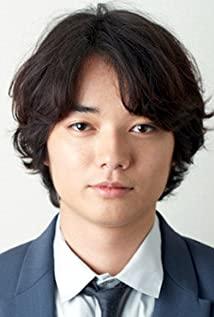Text / Smart
's film "Secrets of Immorality" is the work of Japanese director Sonoko Wen in 2011. Taiwanese film title translation "Secret of Immorality" Mainland translation "Mediocre" Japanese original "ヒミズ" google translates the word as "fire water", the adapted word Gugu Mi's comic word meaning can be interpreted as fire fighting. However, why there can be such different cognitions and interpretations in the three places on the Taiwan Strait is also worthy of our in-depth discussion. From the title of the film, we can see that Taiwan puts the film's central theme on the so-called "morality" level, while the mainland thinks about the film's title and puts it on the "human value". Japan, based on its social background, the director's The title of the film is an important element of disaster relief and first aid as it reflects social events like "fire water". In the same year of 2011, the 311 earthquake occurred in Japan, which caused great casualties and serious incidents of nuclear leakage. Sono Ziwen puts the background of the times and social events into the elements in his films, which can arouse great sympathy and attention from the audience. Sono Ziwen's films seem fantastic and unbelievable precisely because his films are like a mirror reflecting the reality of life, which is blunt and cruel. Watching his movies will have a kind of heartache and can't breathe. After watching it, it is like a catharsis of emotions. I am glad that the two-hour movie is only a small fragment of real life. Injured palm. The earthquake that occurred in 2011 is not only in the memory of the Japanese, but has also become the collective memory of people all over the world through media reports. Taiwan is also listed as one of the top regions for disaster relief donations. After understanding the relevant era background, we can quickly enter into the movie narrative with the marks of the era.
narrative style
The opening scene of the film is a dark and sad gray tone. Following the narration of the heroine's narration, we enter the film's situation, and the tragic symphony soundtrack follows, arousing the sympathy and attention of the audience. Next, we heard the subtle sound of the pointer moving, and then the camera swept across the ruins and ruins after the nuclear disaster and the earthquake. ) murmured the unspeakable sadness in his heart. With the bursts and bombings, the movie seems to bring us back to the reality we experienced at the disaster site. All the objects are dilapidated, and we see the young male protagonist Yuichi Sumida (Shota Someya) kill himself with a gun. Before we can understand the reason, the camera cuts directly to the events of all the destruction. Through the broadcast on the TV screen, we guessed that the background of the story was established in a small town that was hit by the Fukushima nuclear disaster. The rest of the supporting roles gradually appear. We can understand the story through the narration of the heroine, and establish the relationship with the surrounding characters through the hero. We know that the hero in the film is a middle school student who is still studying, while the parents at home are not. I was devastated by the disaster that happened. In the film, his performances are sometimes cheerful and sometimes melancholy, which strengthens the three-dimensional character of the characters. We can find from the story that although the characters in the film have experienced unrecoverable disasters, they still maintain an optimistic attitude and survive, but life is so difficult that we can even see through the places where they live. Identified by a temporary tent house. Residents spend all day talking about their life, destiny and life with nothing to do. In their seemingly boring daily life, they are helpless and sad. Sumita also explained in the movie that he is desperate for his future. Sumita's father (played by Kwang Shi Yan) is an unemployed vagabond who drinks and owes debts all day long. It is not difficult for us to understand the motives behind the characters in such a common plot in social news. And his mother (Makiko Watanabe ) plays the breadwinner of the family, the father goes to the house all day long to ask for money, and the boat rental at the protagonist's house also lacks income due to bad business. So far, the narrative of the movie has shifted from the narration of the heroine to the narration of the heroine. in the subjective narrative of the male protagonist. In the film, the conflict between the characters' inner conflicts and social reality is presented through the rivalry between the male protagonist and his father. The female protagonist intervenes in the story from time to time and plays an auxiliary role. It is not difficult for us to understand in the story that the hero is extremely depressed and angry because of the situation in real life, and his total despair and indifference towards life are established in the first twenty minutes of the story. In the movie, the heroine tries to be the pillar of Sumita with her meager strength, while the kind and kind neighbors Ye Ye (Watanabe Tetsu) and Tamura (Fukie Man) (played) also created a very important bystander narrative in the film. The weather in movies always seems to be a gloomy rainy scene. The heroine's warm and lovely smile seems to try to hide the infinite sadness in her heart, but she has to be strong to help Sumita. She believes that she is the only support for the poor Sumita, and she also naively believes that the role she plays will never turn back, even if she is beaten. Sumita's indifferent sarcasm, she remained optimistic. This scene reminds me of Matsuko Kawajiri, the heroine of Tetsuya Nakajima's film "The Disgusting Matsuko", who is still strong in the face of the sorrow of life, but stronger. The kind neighbors try to dedicate their meager efforts to help the hero's inner powerlessness to cheer up, but in doing so, it highlights his own powerlessness. The male protagonist left the formal education of the school. When all the classmates were working hard to climb up the school, the male protagonist also had great doubts about his own life. However, the heroine's role in the film is a bit too active, constantly trying to intervene in the difficult life of Su Tian, and even plays the role of a virtuous "fiancee". In the movie, Sumita was set by the director as a middle school student who was abandoned by his parents, but after understanding the relationship between the characters, he realized that it is not so simple in real life. The mother's departure was because of her "instinct" that she could not bear too much pressure and made a choice. , just as Sumita his choice was to stay. In Sono Ziwen's story, all the theft, prostitution, gambling, and crime seem to be rationalized. We quickly agree that the characters' motivation is the helplessness of life, because if they didn't do it, they couldn't continue to exist in the world. Only those who have truly experienced difficulties in life can understand the pain of the extreme inner contradiction. Yuan Ziwen's films seem to be cruel, but what is more important is the care and love for the world. He explained that the audience is like a helpless character trapped in the frame of the film. We are fascinated and exist for no reason, challenging our lives. May encounter all the total unreasonable encounters, depression and depression, but they resist with all their might. The audience's role as a bystander can only sympathize, and they are glad that they are not the characters in the film. This is different from traditional Hollywood or European and Western film narratives, where the viewer longs to be the protagonist in the film, and even mistakenly believes that he is the admirable and enviable character in the film, agreeing and misidentifying. Sono Ziwen's cinematic narrative alienates the audience, and we can only sympathize but do nothing. The heroine in the movie, on the surface, seems optimistic about life is based on her actual life and is extremely unoptimistic. Like Sumita, the heroine is a character abandoned and hated by her family. Her mother wants her to die. (Even in the movie, it is spoken directly using lines.) This is a You don't usually see it in traditional movies, and even if you do, it's just a joke, but in this movie, the kind of "tell you to die" is an extremely serious and serious statement. You even start to wonder why you need to exist, just as Jingzi's mother pointed at the hanging rope sternly and asked the heroine to hang herself immediately. Sono Ziwen's films are good-looking and beautiful because the characters in the films seem to have lost their clearly opposed class positions. The characters in the movie live peacefully in a life that they cannot choose and cannot escape. Each has its own misery and helplessness. The audience will not want to be any character in the movie, because it is so tragic and so equal. The male protagonist's angry shouting in the movie is like an indictment of the world, the cynical youth yearns for the world's total destruction, because there is no hope of getting better, and his madness is only a kind of human being. There is only strength left to resist. The blood of being beaten and beaten for debt collection can only do so. Ye Ye also plays a main supporting role in the movie, because his narrative also occupies a lot of space in the movie. From the few scenes where he started to raise money for the male lead, we can understand that he also has his own troubles that he cannot solve. , but he projected his hope of living on the young protagonist Sumita. For Sumita's debts, he stole, robbed, and did many things that were not allowed by social and moral laws. Thinking about moral issues from the title of the film in Taiwan, I made a small comment for the entire decadent generation in the so-called murder, theft, and abandonment of the family in the hot and cold world. And through the title of the mainland film, the reason why people exist is to contribute to the whole world. The narrative of the film probably makes a summary here, and then discusses the style and form of the film. Debt beating blood can only be so. Ye Ye also plays a main supporting role in the movie, because his narrative also occupies a lot of space in the movie. From the few scenes where he started to raise money for the male lead, we can understand that he also has his own troubles that he cannot solve. , but he projected his hope of living on the young protagonist Sumita. For Sumita's debts, he stole, robbed, and did many things that were not allowed by social and moral laws. Thinking about moral issues from the title of the film in Taiwan, I made a small comment for the entire decadent generation in the so-called murder, theft, and abandonment of the family in the hot and cold world. And through the title of the mainland film, the reason why people exist is to contribute to the whole world. The narrative of the film probably makes a summary here, and then discusses the style and form of the film. Debt beating blood can only be so. Ye Ye also plays a main supporting role in the movie, because his narrative also occupies a lot of space in the movie. From the few scenes where he started to raise money for the male lead, we can understand that he also has his own troubles that he cannot solve. , but he projected his hope of living on the young protagonist Sumita. For Sumita's debts, he stole, robbed, and did many things that were not allowed by social and moral laws. Thinking about moral issues from the title of the film in Taiwan, I made a small comment for the entire decadent generation in the so-called murder, theft, and abandonment of the family in the hot and cold world. And through the title of the mainland film, the reason why people exist is to contribute to the whole world. The narrative of the film probably makes a summary here, and then discusses the style and form of the film.
Form and style
We pick out several clearly identifiable forms from several elements of the film: mainly from the soundtrack in the film, the narration point of view, the assembly of shots, the use of colors, scenes and props, etc. To do a detailed analysis:
the soundtrack
in the movie: the background music that repeatedly appears in the movie is the use of the well-known Mozart Requiem. It seems to be a constant reminder of our serenity yet urging us to reflect on the meaning of life. This kind of symphony, which seems to be often heard in the towering Western-style churches, has its unique meaning and function when it is used in the soundtrack of the movie. The music itself sounds sad and sad, but it is so quiet and peaceful, like mourning an unspeakable life. It is used in the movie and echoes the repeated motif of the movie. If you understand Mozart's Requiem The story behind the song, we can even know why the clever director chose this soundtrack.
Sound design in the movie:
In the movie, the booming sound and the humming sound of nuclear energy leakage are all handled in very subtle ways in this movie, and the audience can hear it from the main visual elements of the entire movie. In terms of hearing, the audience can more enter into the theme of the movie. Of course, in real life, the sound effects of this type of design are not easy to pay attention to, but in the characteristics of the film, it is easy to be highlighted so that the audience can perceive it. Especially the tinnitus and auditory hallucinations that the male protagonist keeps appearing after killing people in the movie is the sound element added by the special sound effect design of the movie, so that the audience can get closer to the inner situation of the protagonist. Accompanied by the humming sound of the explosion, there is a deeper sense of layering throughout the film.
Narrator:
The use of narration in the film's narrative is extremely elegant and appropriate in this film. The audience will not feel the nagging thoughts while watching, but instead creates a high degree of connection and identification between the audience and the mood of the protagonist of the film. The narration also serves as a moderator here, allowing us to understand the narrative of the story, but at the same time hold the position of an alienated bystander, not directly into the state of the characters. The narration used here is more important, in addition to the verse-like narration composed by the talented director himself, as mentioned above, the original verses used are excerpted from the "Ballade des" of the French poet François Villon, which is called "the cursed" in modern times. menus propos" (Ballad of small talks)
"Ballade des menus propos
Je connois bien mouches en lait,
Je connois à la robe l'homme,
Je connois le beau temps du laid,
Je connois au pommier la pomme,
Je connois l'arbre à voir la gomme,
Je connois quand tout est de mêmes,
Je connois qui besogne ou chomme,
Je connois tout, fors que moi-mêmes.
Je connois pourpoint au collet,
Je connois le moine à la gonne,
Je connois le maître au valet ,
Je connois au voile la nonne,
Je connois quand pipeur jargonne,
Je connois fous nourris de crèmes,
Je connois le vin à la tonne,
Je connois tout, fors que moi-mêmes.
Je connois cheval et mulet,
Je connois leur charge et leur somme,
Je connois Biatris et Belet ,
Je connois jet qui nombre et somme,
Je connois vision et somme,
Je connois la faute des Boemes,
Je connois le pouvoir de Rome,
Je connois tout, fors que moi-mêmes.
Prince, je connois tout en somme,
Je connois coulourés et blêmes,
Je connois mort qui tout consomme,
Je connois tout, fors que moi-mêmes.”
Chinese translation
"I know that flies fall into milk, black and white at a glance; I know it, I know it. I know identity by clothing, and I know that; I know the weather, I know it, I know it; I know that I can recognize apples; the diligent and the lazy can see at a glance, and know everything except myself. In short, I know it. A healthy face is very different from a pale face, and I too Know; death will bring an end to all things, and everything is clear in your heart, except yourself."
Anyone who is familiar with Sono Ziwen's films or who has studied them knows that Sono Ziwen's background is a poet, and he is not It is difficult to understand that in his films, "poetry" plays a very important role in his series of films, which echoes the motif that the director wants to convey to the audience through narration. The poetic narration is the most concise and concise. The words of François Villon continue to imply the core concept of the audience's story, which is why Sono Ziwen's films have one of its unique image styles. The verses quoted here are also like the bleak life history of François Villon, who was unsuccessful in his death and was accused of murder On charges of theft, the verse was published after death.
Narrative point of view:
In common narrative films, it is a matter of course that there is at least one main narrator's point of view, so that the audience can understand the context of the whole story and what the message is intended to convey. Taking this film as an example, we learned that from the very beginning, the audience started the narration from the narration of the heroine. Through Francois Villon's verses, it directly entered the core of the story, expanded outward, and then extended to the hero Sumita. The movie is not a single-line protagonist's narrative point of view, but a continuous extension through a somewhat "tree-like structure", first is the narration of the heroine, then the point of view of the hero Sumida, and then the narrative point of view of the neighbor Ye Ye, from his point of view to tell the story The whole event, staggered and back to the main character's point of view, but we still know who the main focus of the story is. The narrative of this kind of narrative point of view can describe the overall storyline more objectively, and it is easier to convince the audience.
Lens combination:
Most of the shots in the film adopt a more objectively stated perspective, and there are also a few close-up and close-up shots that depict the characters' expressions, showing the character's bewildered state of mind. The use of lens language in movies is also extremely common, so I will not describe them one by one here. What is more special is the big vision in the movie, which takes us across the entire disaster area and inserts nuclear disasters from time to time. There are also jump shots used in the scene where the hero is going crazy on the street, and the scene where the hero quickly cuts to the scene of a messy shootout when the hero is desperate, all of which are very important lens elements in the hero's fantasy. A stylized lens set similar to Quentin Tarantino and a comic-style storyboard.
The tone of color in the movie:
Most people who have seen Sono Ziwen's movies can appreciate the use of color in his movies, which is a combination of two contradictory complexes, dark but warm. The use of color in the film is very suitable to bring out the psychological state of the characters and establish the narrative style of the overall story. For example, the gray tone of color at the beginning of the film, the dark and gray sky, has almost established the main narrative tone for the entire film. The film is "too dark", which can actually be criticized and proved after a detailed study. Of course, there is no shortage of elements with gray as the main tone in his films, but if you pay more attention to the color tone between different scenes, you can find bright colors that still have warm colors. In her early films, she liked to use black and red to emphasize "loss" and "eroticism". In this film, the gray and dark colors in his films are still followed. What is more special is that the red tones are less used in this film, and bright greens and warm yellows are used
instead of dark colors in the past. The tones have also shifted to gray-based colors. Compared with the evil and terrifying visual experience that black brings to people, the feeling of gray in the film vision is more confused and hopeless. This is also an important use of color in film elements. The bright and warm colors in this film also illustrate the director's careful and subtle hope. For example, when the male protagonist walks to the street in despair, he hears someone performing a live performance on the street, and the tone turns to a warm yellow tone, but at the same time, the dark tone of the protagonist's heart is hidden in the interplay between the two.
Scenarios and mise-en-scène:
The design of this scene is actually relatively simple in this film, mainly the scene of the houseboat and the scene on the street or school, which is used to establish the identity of the protagonist and the relationship between his position in society and so on. If you have seen the director's other films, it is not difficult to understand that the director's focus is actually on the interaction between marginal characters and society. Therefore, we will not only be immersed in elegant and gorgeous scenes, but we can also experience the interaction between characters and society through the setting of director scenes. This is one of the most important considerations in the selection of the scene. It is worth mentioning that the scene scheduling is probably because the director did not particularly use the state of the front and back of different characters in the dialogue. Most directors like to integrate the whole scene to establish a good relationship between the characters and the environment. When the characters are in dialogue, we can also detect the mood of the listener who does not speak.
Display of props:
There are often special props in Yuan Ziwen's films, such as chain-like props, prisons, knives and guns, etc. The things that people often associate with sin are very important elements in his films. The Elements movie didn't go well either. It is worth mentioning that in this movie, the girl wearing chains all over her body walks out to throw the garbage in the scene. Here, the props also serve as metaphors and hints. In addition to the state that is more difficult to see in reality, we can speculate that this supporting role also refers to the "chain-like life" of the protagonist or other people who exist in the movie. The houseboat and tent also refer to the wandering and lost state of the characters in the movie, and the elements here can also be compared to the movie elements that Kim Ki-duk likes to use in his films. Beautiful and worth mentioning is one of the scenes where the lit light bulbs hang around the houseboat, the neighbors gather around and dance happily, how elegant and peaceful the description is, or the two protagonists in the The white candles lit in the dimly lit houseboat are like a small flame still lit in the heart of all the despairing world.
Due to space constraints, a full-length conclusion is made here. From the above discussion of narrative style and formal elements, we can roughly understand that although the whole film shows the fear and despair of the future in Japan after the severe disaster in 2011, Sono Ziwen still remains in this film. Remind the audience that in a world of despair, there are still parts worthy of our attention and efforts. Not all his films are just complete despair. In the series of films that have watched him, we can see that he is actually sentimental but It is also warm and healing. Using the above adjectives to define his films is not a very objective approach. However, if we can go deep into the director's inner world, we can pay more attention to the helplessness and sadness of the world through the dialogue lines he composed, or the small elements that constantly remind us in his films. Sono Ziwen's image language is a poetic sonata, which continues to play various lamentations of life and society. However, through the sadness behind these characters, we can only realize what true happiness is when we look back and examine ourselves. The beautiful word "happiness" has long been abused by human beings in modern society, and it has become a lost and distant myth. Everyone yearns for happiness, and is constantly pursuing the happiness defined in his head, but the happiness that everyone can feel is so different, yet so the same. Sono Ziwen's film is a cold and sad loss. Sono Ziwen's film is also warm and real and moving. It is difficult for us to imagine what kind of treatment we will encounter after being sad to the extreme of despair. Is it suicide? Or stay alive? And where does this power come from? It's like the movie's finale rebirth after the hero Sumida can't resist all despair and wants to shoot himself to escape this disgusting decay. It is like the crucified Jesus in the biblical mythology, who was crucified by the lost world on the cross, tortured to death and then brilliantly resurrected. Sumita fired and roared through the sky, we thought we were saying goodbye, but after all this suffering ended, the gunshots disappeared as if in the past, he appeared in the water and woke up. The ending of the film is extremely moving And the tears continued to flow, and the camera swept across the desolate scene of the disaster area, and the two protagonists in the film shouted "頑張って!!" to each other. That kind of inspirational power is what everyone is most eager to hear when they are desperate. The voice, shouting through the protagonist's lines, seems to encourage each other, but it is actually an encouragement and a shout to the entire Japanese society or the entire human world. Each of us hopes that the world can become better and more perfect, but after suffering
View more about Themis reviews











